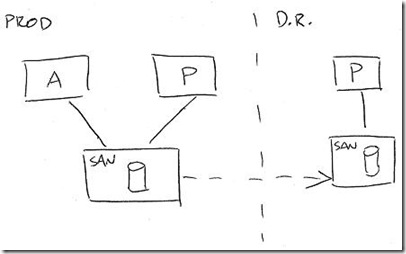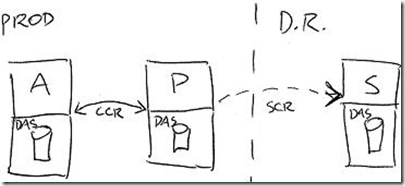Advantages of DAS over SAN storage in Exchange 2007
You may have heard me talk about this at TechEd, and some of my customers will recall long discussions with me about the merits of using Direct Attached Storage rather than SANs in Exchange 2007.
Storage Area Networks (SAN) have become increasingly common in Enterprise environments in recent years, and in particular for hosting Exchange Server environments due to their space and IO requirements.
There are many advantages to using a SAN with Exchange:
- Performance - Exchange 2003 is a very IO intensive application, and in any decent-sized environment disk IO is almost always the bottleneck
- Scalability - we're storing more data than ever before and although technologies like Sharepoint relieve some of the burden from Exchange, the fact is that mailbox sizes continue to grow as we move into the age of UM and UC.
- Availability - consolidating your storage provides a single system to maintain and backup, and allows you to build HA/DR into the storage system to protect all of your data.
However Exchange 2007 introduced some new concepts, which has changed things somewhat.
- Performance - by moving to a 64-bit platform (which does not have the virtual memory limitations of its 32-bit predecessors) we have significantly reduced the IO impact in Exchange, by about 70% on a mailbox server! Modern DAS technologies such as Serial Attached SCSI (SAS) are capable of providing more than enough IO for Exchange 2007.
- Scalability - SANs are expensive, so as storage requirements increase so does the TCO of the environment. For example, at Microsoft the high costs associated with shared SAN storage hindered MSIT from supporting employees with mailbox quotas of greater than 200 MB.
- Availability - SANs don't fail often, but they do fail - and when they do it can be catastrophic. Three of my Exchange 2003 customers have had SAN failures this year, and in each case it took several days to return Exchange to full operation. Two of these customers were using SAN replication technology which actually replicated corrupt data to the DR site, taking it out and making the restore process much more complex (and defeating the whole purpose of the replication IMHO). Exchange 2007 introduced CCR and SCR, which provide software-based replication for HA and DR eliminating single points of failure, and providing simplified site resilience and DR.
Figure 1: a typical Exchange 2003 2-node cluster using SAN replication for DR
The two diagrams above, which are scanned from some scribblings on paper I drew in a recent Architectural Design Session with a customer (apologies for the messiness - I'm so used to keyboard/mouse than my handwriting skills have declined :)), show their existing Exchange 2003 cluster and a proposed Exchange 2007 cluster.
The advantages of the Exchange 2007 environment here are:
- Increased availability in Prod datacentre - there are two copies of the database, with automatic failover, meaning no single point of failure. The SAN environment in Figure 1 has only one copy of the DB in Prod, meaning that any DB failure will result in a cutover to DR. CCR in Figure 2 provides fault tolerance in the event of server failure, storage failure and data corruption.
- Enhanced Disaster Recovery - using SCR to replicate data to the DR site, there is now a fully supported and simple to manage DR process in place. In Figure 1, data corruption in Prod could be replicated to DR, meaning that restore from backup would be required. In Figure 2, SCR will not replicate corrupted data as it used transaction log shipping to replicate.
- Reduced TCO - there may be more copies (3) of the data in Figure 2, but the usage of DAS disks will significantly reduce the cost of storage which will likely more than offset the cost of the additional disks required.
So how does it work in the real world? A great example of the benefits of moving from SAN to DAS is our internal MSIT case study.
We saw benefits such as:
- Messaging service levels exceeding high-availability targets of 99.99 percent.
- Cost reductions in excess of $10 million per year.
- Increased mailbox quotas by up to a factor of 10.
- Consolidation of the initial Exchange Server 2007 base by nearly a factor of two.
The MSIT whitepaper can be found at the Technet site, in Word format, as a webcast, or as a podcast (WMA, MP3).
| Share this post : |
Technorati Tags: exchange 2007, storage, ccr, scr, san, das, planning, msit, download

